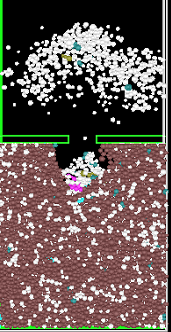Numerical simulations of sand production in oil wells using the CFD-DEM-IBM approach
Published in Journal of Petroleum Science and Engineering, 2021
Recommended citation: Rakhimzhanova, A., Thornton, C., Amanbek, Y., & Zhao, Y. (2021). Numerical simulations of sand production in oil wells using the CFD-DEM-IBM approach. Journal of Petroleum Science and Engineering, 109529. https://doi.org/10.1016/j.petrol.2021.109529

“Three-dimensional CFD-DEM-IBM simulations of sand production in a sandstone formation, using periodic boundaries, were performed using 10000 frictional elastic spheres bonded together and compressed at 1 MPa of overburden pressure. Sand production simulation geometry and procedures are proposed, in which the cone penetration test (CPT) has been used to investigate the physical perforation penetration of the cemented sandstone material with the real-world grain size distribution from the Ustyurt-Buzachi Sedimentary Basin. The Immersed Boundary Method (IBM) was adapted for the sand production simulation geometry to simulate the fluid flow near the well casing. Oil with low viscosity and density was used as an injection fluid (reservoir fluid). This study shows what happens in the first 0.1 s immediately after perforating of the cased horizontal oil well. Erosion near the perforation tunnel was triggered due to the pressure drawdown, where the production of sand particles was initiated during the first flow due to the drag force that lifted the sand particles from the perforation damage zone. At the beginning of the simulation a sand arch was captured around the perforation tunnel and due to the fluid flow it collapsed and the perforation cavity became larger. The amount and mass of produced sand particles were calculated. The research findings provide insight into the sanding process and could be helpful for practicing engineers to understand the sanding mechanism at micro and macro scales. The results show that the proposed model is promising, and the innovative CFD-DEM-IBM-based system should be further elaborated to simulate the sand production in a sandstone formation.”
